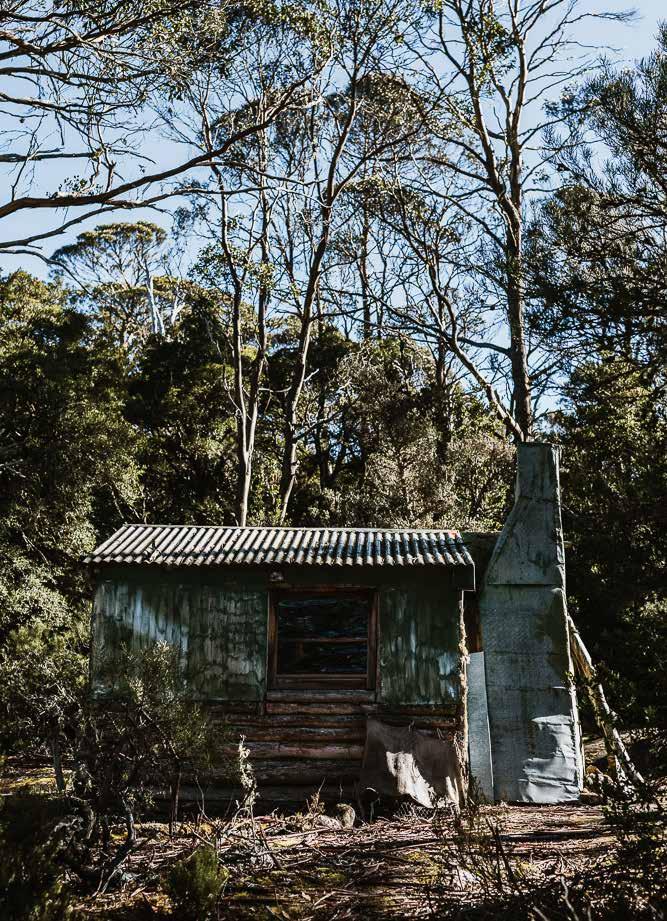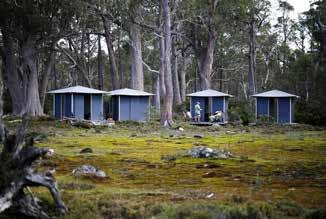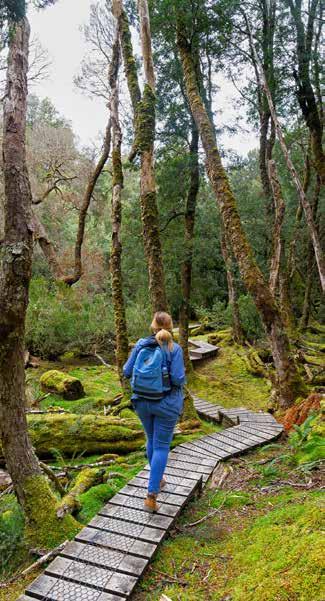
7 minute read
Tourism profile: Daniel & Simone Hackett
Tasmania’s remote wilderness conjures images of tranquility.
But that perception has been shattered for one couple with a dream of combining conservation with highend tourism.
Advertisement
Daniel and Simone Hackett have been thrust into the political and legal spotlight as they fight to develop a small ecotourism business in the Walls of Jerusalem National Park, alongside an historic hut that they are custodian of. Never did the couple think they would be subject to death threats and intimidation on their quest to expand their successful tourism business. From the pinnacle of Australian Tourism Awards glory just a few years ago, to facing financial and emotional ruin, the Hackett’s say they’ve been vilified for using the State Government’s “Expression of Interest” process for tourism development in Tasmania’s Wilderness World Heritage Areas. Their vision seemed simple enough. Daniel, who is now a director of the TICT, had fished since he was three, learning the intricacies of the sport in the Snowy Mountains with his parents. He met Simone while studying aquaculture at University and she soon fell in love with the pursuit, eventually becoming one of only four females in the Southern Hemisphere to achieve International Federation of Fly Fishers casting instructor qualifications. They started their business RiverFly in 2004 when the tourism industry was in decline - taking the punt with a one page website and 250 business cards, initially offering fly fishing day trips around the Northern Midlands. In 2012 they were given a licence to establish a wilderness camp at Skullbone Plains, named after the dead bushrangers and escaped convicts found at the location, 10km northeast of Lake St Clair. A standing camp was erected on the former Gunns land, now owned by the Tasmanian Land Conservancy. Their four upmarket huts were used 10 times a year by anglers as a base to fish Lake Ina and surrounding areas. It was deemed a flagship product for Tourism Australia, used as a Signature Experience Program for marketing and in 2016 was awarded the Australian Tourism Award for a Specialised Tourism Service. “It was the pinnacle of our business careers because it recognised our innovations, and we proved that a small tourism business operation could coexist comfortably with a World Heritage Area,” Mrs Hackett says. The business boomed with never a whisper of discontent or dissatisfaction. But there
Artist impression of the Halls Island Standing Camp (by Cumulus Studio).
would be a dramatic deviation following the government approval of their EOI for a new ecotourism development at Hall’s Island on Lake Malbena. Never heard of among the general public, the location will become synonymous with the great Tasmanian environmental debate. Hall’s Island is around 8ha of land which can only be accessed via a 70m trip in a row boat. On the island sits a historically important private hut built by Reg Hall and Dick Reed in 1956, who explored, cut tracks, mapped and named key landmarks in the area. The Hackett’s were offered custodianship of the hut in 2014 from the secondgeneration owner, on the provision that the heritage of the building and the island would be promoted and protected for future generations. “We agreed, on the basis that we could offset our costs and achieve the goals through a small scale, sensitive tourism operation, and that just happened to coincide with the State Government opening the EOI for tourism process,” Mr Hackett said. They proposed to install four small pods about 30m away from Hall’s Hut - three accommodation pods measuring 3m x 3m and communal pod measuring 5m x 4m to facilitate nature tourism such as bushwalking, historical interpretation and kayaking. “The standing camp footprint is tiny, and it’s 15km away from the famous picture postcard part of the Walls of Jerusalem that 7000 people a year go to visit,” Mr Hackett said. But nothing could prepare the couple for the fight they’ve endured against those opposed to the concept - with many angered by the use of helicopters to fly visitors to the area. “If you are a recreational bushwalker you can go anywhere and bushbash
your way in to Lake Malbena across sensitive wetlands. But commercial operators are held to a higher standard. The only way that we can access the site in an environmentally friendly fashion is via a 9-minute helicopter flight, which also provides equity of access and diversity of experience to a wider range of visitors,” he said. “We have capped the number of bookings to 30 a year - which in turn deliberately restricts the amount of helicopter use we’ll require. Only 60 days per year will feature flights, and our use is capped at a total 40 odd hours per year, flying along the eastern boundary of the TWWHA. The landing is outside of the national park. We believe the impact is measurable and minimal. “There are plenty of other tourism operators who conduct scenic flights over the area, but because we are landing to drop off and pick up visitors, it is regulated more much more strictly.” The project received conditional State Government approval under the EOI process through a State Reserve Activities Assessment. A Federal Environment Protection and Biodiversity Conservation Act assessment was approved in September 2018, after 6 months and two public comment periods. That approval was appealed by the Wilderness Society, which was upheld in November, 2019, on legal grounds. A parallel planning process for a development application was also required by the Central Highlands Council.
One of the original Walls Of Jerusalem bushwalking maps, by Reg Hall (Supplied D Hackett).

Despite a recommended approval, the council voted against the DA at a meeting that ended with police presence to control crowds. That decision was successfully appealed at the Resource Management Planning and Appeals Tribunal in November, 2019. However, the Wilderness Society appealed the DA to the Supreme Court in July 2020, unsuccessfully, and have since lodged a second appeal to the Full Bench of the Supreme Court. “Tasmania is world famous academically as a leader of environmental conflict - don’t forget that it took Simon Currant 14 years to do Pumphouse Point, Saffire took seven years to get approval and the Overland Huts and Three Capes Track faced stiff opposition from the same groups,” he said. This is the new frontier in environmentalism, it’s called lawfare, and at the end of the day the opponents will keep arguing the legalities and keep going in circles in an attempt to cripple us financially.
The historical Halls Hut (image A Gibson).

Simultaneously, the Tasmanian Land Conservancy have not renewed the Hackett’s licence for their original business at Skullbone Plains, 10km south of Lake Malbena and also in the World Heritage Area, in what they label a political decision. “It’s an absolute absurdity, we generated $170,000 worth of cash and in-kind funding for the TLC and conservation. Now the TLC has put our business in jeopardy and put at risk three full-time equivalent staff, 500 associated room nights of accommodation and the associated business that generates for restaurants and cafes - the flow on effect of this decision is actually quite massive,’’ Mr Hackett said. “There has been no explanation why.” After five years of fighting, the Hackett’s say they are more determined than ever to succeed. “We believe in what we are doing. The science stacks up, and we’ve followed the assessments to the letter. Commercial tourism, high-quality presentation, equity of access and experience are all important goals of the TWWHA Management Plan,” she said. “We have had many death threats over phone calls, and things stolen and vandalised. I can deal with certain things but when you get Tas Police call and say they are
RiverFly’s standing camp at Skullbone Plains. (Supplied D Hackett).

concerned for your welfare, its is extremely concerning, especially when you have children. “But we won’t give in to the ideological bullies. I don’t like extremists, and I am happy to beat them on the science, and I know that once we are operating Tasmanian’s will think it is great because it will be another sustainable and iconic product.” As we go to print, the project is being reassessed with a third round of public consultation via the EPBC and a decision is expected in December. The RMPAT appeal was heard in October and a decision on that is also expected before the end of the year.
Words by Rachel Williams, Millwood Media
Christmas is just around the corner, and the Hackett family is hoping for a miracle. “We have already outlasted four state ministers and three federal ministers, and giving up is not in our DNA,” Mrs Hackett said. Watch this space!
The Podcast Series for Tasmanian tourism operators and industry professionals.
60 Bite Size Conservations with our best and brightest, the influential and the inspiring in Tasmanian tourism. Listen in the car, at the desk, in the shower, walking the dog… Wherever and whenever suits you. Best of all, they’re 100% FREE
Stream from www.tict.com.au Or search for ‘Talking Tourism’ wherever you get your Podcasts.
Talking Tourism is an initiative of






